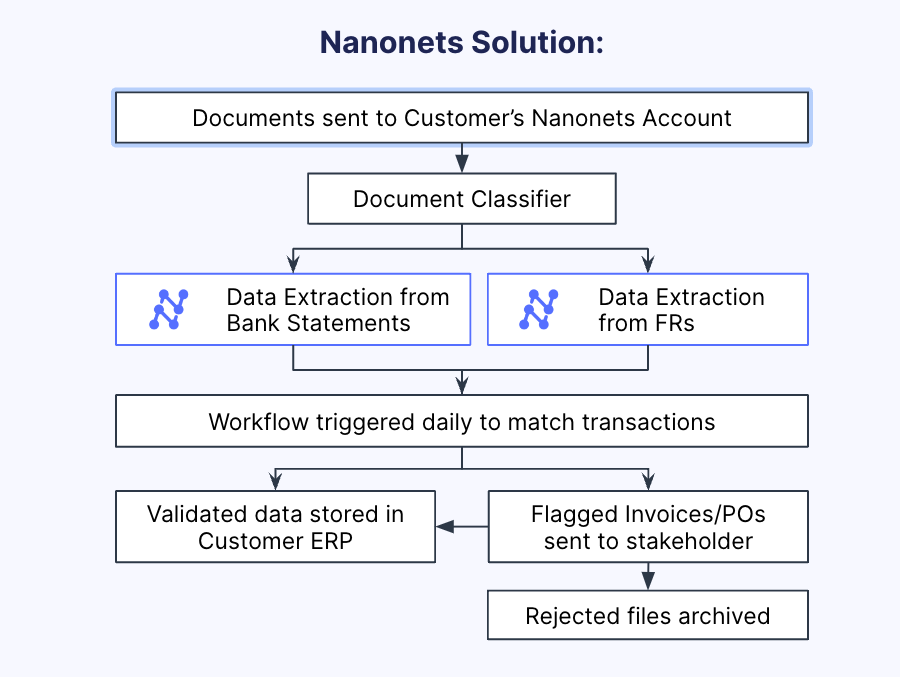
Introduction
Accuracy and efficiency are non-negotiable in the processing of payments in any company, be they payments received by the company for products/services rendered, or made to vendors for products/services received. Payment reconciliation is the process of verifying all payment transactions. It involves comparing transaction records from various sources, such as invoices, bank statements, and payment receipts, to identify discrepancies and errors. As enterprises expand and transaction volumes escalate, the manual execution of payment reconciliation becomes increasingly laborious and susceptible to errors. Herein lies the transformative potential of payment reconciliation software. Not surprisingly, Fortune Business Insights reports that the global reconciliation software market is projected to grow from $1.28 billion in 2023 to $3.40 billion by 2030, at a CAGR of 14.9% during the forecast period.
What is Payment Reconciliation Software?
Payment reconciliation software tools are designed to automate and streamline the process of matching and reconciling financial transactions within a business. Its primary function is to compare various transaction records, such as invoices, bank statements, and payment receipts, to ensure accuracy and consistency in financial data. By leveraging advanced algorithms and data analytics, payment reconciliation software identifies discrepancies and errors, facilitating precise reconciliation. While the specific steps involved in Payment Reconciliation may vary across businesses, the general process is as follows:
- Data Collection: All relevant financial documents and records are collected, including bank statements, invoices, receipts, and accounting system records, to verify payment accuracy.
- Transaction Matching: Bank statement records are compared with entries in the accounting system, ensuring consistency in transaction dates, amounts, and descriptions.
- Discrepancy Identification: Inconsistencies or discrepancies are identified. These may arise from timing differences, errors, or fraudulent activities.
- Discrepancy Resolution: Discrepancies are analyzed to determine their causes, possibly involving communication with issuing banks or reviewing original transaction documents. Correct or adjust accounting records accordingly.
- Adjustment Recording: Adjustments in the accounting system are made to reconcile accounts, such as accounting for bank fees, interest earned, or rectifying errors.
- Balance Verification: The adjusted balance in the accounting records is matched with the ending balance reflected in the bank statement.
- Documentation: Comprehensive documentation of the reconciliation process must be maintained, including details of discrepancies and adjustments, for audit trail purposes, ensuring accountability and transparency.
- Review and Approval: Depending on the size and structure of the enterprise, a supervisor or manager may review and approve the reconciliation process to ensure its accuracy and completeness.
Payment reconciliation is performed at regular intervals, such as monthly or quarterly. The payment reconciliation software automates many of these steps thereby saving time and money.
Benefits of Using Payment Reconciliation Software:
Using payment reconciliation software offers a range of benefits for businesses:
- Increased Efficiency: Automation of repetitive reconciliation tasks saves time and reduces manual effort, allowing staff to focus on more strategic activities.
- Accuracy and Precision: The software employs advanced algorithms to systematically compare and match transaction records, minimizing the risk of errors or discrepancies in financial data.
- Cost Savings: By streamlining reconciliation processes and reducing manual labor, businesses can achieve cost savings associated with labor hours and potential errors.
- Improved Compliance: Payment reconciliation software helps ensure adherence to regulatory standards and financial compliance by maintaining accurate and transparent financial records.
- Enhanced Visibility: Real-time insights and analytics provided by the software offer greater visibility into financial transactions, empowering informed decision-making and strategic planning.
- Faster Decision-Making: With timely access to accurate financial information, businesses can make faster decisions regarding cash flow management, budgeting, and forecasting.
- Scalability: The software is designed to accommodate growing transaction volumes and expanding business needs, providing scalability without compromising performance.
- Reduced Fraud Risk: By promptly identifying discrepancies and irregularities in financial transactions, payment reconciliation software helps mitigate the risk of fraud and unauthorized activities.
- Customer Satisfaction: Accurate and timely reconciliation ensures that customers are billed correctly and payments are processed efficiently, contributing to improved customer satisfaction and loyalty.
- Strategic Insights: By analyzing reconciliation data, businesses can gain valuable insights into payment trends, customer behavior, and operational efficiency, enabling them to optimize processes and drive business growth.
Key Features to Look for:
here are some common features found in payment reconciliation software:
- Data Integration: Seamless connectivity with various data sources such as ERP systems, banking platforms, and payment gateways.
- Matching Algorithms: Advanced algorithms for comparing and matching transaction records based on customizable criteria.
- Reconciliation Rules: Customizable rules and parameters for automating the reconciliation process according to specific business requirements.
- Dashboard and Reporting: Intuitive dashboards and reporting tools for real-time insights into financial transactions and reconciliation status.
- Scalability: Ability to handle large transaction volumes and accommodate business growth.
- Flexibility: Adaptability to evolving business needs and changes in reconciliation processes.
- Security Features: Encryption protocols, access controls, and data protection measures to safeguard sensitive financial information.
- Audit Trails: Comprehensive audit trails to track changes and maintain a transparent reconciliation process.
- Exception Handling: Mechanisms for identifying and resolving discrepancies or errors in reconciliation.
- Integration with Accounting Systems: Integration capabilities with accounting software to ensure seamless data flow between reconciliation and accounting processes..
Best Payment Reconciliation Software
With the increasing demand for reconciliation software, the market offers a plethora of options for companies to choose from. Selecting the best solution involves careful consideration of the company's specific needs and requirements. Companies should assess the features and functionalities offered by different reconciliation software, considering aspects such as automation capabilities, scalability, integration with existing systems, and security measures. Additionally, evaluating vendor reputation, customer reviews, and support services can provide valuable insights into the reliability and effectiveness of the software. The following table presents the best features of a few popular Payment Reconciliation Automation Tools
The best payment reconciliation software – Nanonets
AI-powered Nanonets can help you automate payment reconciliation. It can automate the retrieval of financial transactions from various sources in real-time, eliminating the need for manual data entry and reducing the risk of human error. Utilizing OCR technology and machine learning, our software extracts payment transaction data and validates it against ledger entries, highlighting any discrepancies for further investigation and correction. This automation not only saves businesses significant time and effort but also ensures immediate attention to any discrepancies identified during the process.
Check out Nanonets Reconciliation where you can easily integrate Nanonets with your existing tools to instantly match your books and identify discrepancies.
Nanonets' customizable approach allows tailoring of the software to match the unique workflows, data formats, and reporting needs of each business. Our team of experts collaborates closely with clients to understand their specific reconciliation processes and develop customized solutions that streamline operations and enhance accuracy.
Nanonets facilitates supplier payment reconciliation, ensuring that payments made to suppliers align with invoice details. It also enables the reconciliation of both inter and intra-company payments, further enhancing financial integrity and transparency.

With seamless compatibility with hundreds of tools, including Gmail, Quickbooks, Xero, and Stripe, Nanonets streamlines operations and boosts efficiency effortlessly.
By implementing Nanonets' payment reconciliation software, businesses can significantly reduce fraudulent transactions by up to 60%, enhance financial integrity by about 80%, and achieve 90% compliance with regulatory standards. This not only ensures safer financial operations but also mitigates potential legal issues and fines.
Take Away
With digitalization surging across sectors, reconciliation software demand peaks, notably in the retail sector. The rapid growth of E-commerce's, driven by urbanization and favorable policies, has resulted in large enterprises and SMEs turning to reconciliation software. This adoption offers promising solutions, providing swift insights and enhancing market presence. Nanonets and similar firms pioneer this shift, integrating AI and machine learning into their software models. In navigating financial complexities, reconciliation tools such as Nanonets have become essential to mitigate risk, drive market growth and promote sustainable financial operations across the enterprise.



